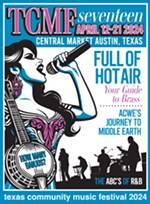Sleazy Listening
Scamping Through the Cocktail Revolution
By Kate X Messer, Fri., Dec. 13, 1996
 |
According to the post-modern primer to old modern music The Cocktail: The Influence of Spirits on the American Psyche by Joe Lanza (also author of Elevator Music: A Surreal History of Muzak Easy-Listening, and Other Moodsongs):
"Just as the cocktail is designed to retain a modicum of order in a chaotic world, cocktail music's blend of pianos, vibraphones, guitars, and sultry ballroom orchestras is fashioned precisely to allay the nightclub's potential bedlam of bristling egos, inebriated banter, and clinking crystal."
Almost 20 years ago, in the chain of steamy suburbs of the geriatric megalopolis known as South Florida, I began my flirtations with the cocktail crowd. The Original Cocktail Crowd. Already cynical of the swinger's bar and disco scene, I longed for a place to drink where everybody knew my name... but not my age (15 at the time). My best friend, Miguel Romero Sanchez Eduardo Francisco Banks found the perfect, exotic hideaway.
The 5101 was one in a long line of noble roadside taverns that took its name from its street address: 5101 S. Dixie Highway. It was love at first sight. There was lots of wood paneling, lots of red naugahyde. The bar was loaded with exotic bottles and veterans from every 20th-century war, and the jukebox was blasting Rosemary Clooney. And if all this didn't make me feel right at home, the warm, "Well, hey there, young people! Come right on in!" melodiously chirped by the graying cigarette alto behind the counter sure did.
 |
Hotel bars rarely carded, and Bristol's and Top O' the Spray never did, so they got plenty of our business, as well. Duncan Neville, a lounge lizard who played the Palm Beach resort circuit, held court for long stays at our favorite seaside lounges. Neville, who frighteningly resembled Kenny Rogers, played a multi-leveled keyboard setup. His one-man-band repertoire consisted mostly of standards, sprinkled with Sixties pop hits like "The Look of Love," and modern rock hits done rather lethargically, much to our delight. Two of Neville's trademarks secured a longtime fan in me: First, his lead breaks which climaxed with him whipping out and wailing on a trombone, missing nary a beat on the keys nor rhythm machine, and second, his huge sombrero, on which were stitched the words that became our barroom mantra, "Kill! Kill! Kill!" But let's go back even further. Most of us born in the time of "Camelot" and "The Great Society" remember time as beginning with rock & roll. Some of us, however, are doomed with an abnormal fascination for the real pop music of the era. For me personally, the impact of four records colored all my future musical encounters: The George Mann Orchestra's Music to Watch Girls By, Living Guitars' Teen Beat Discotheque, The Man From U.N.C.L.E. soundtrack, and what many mistakenly lump into the rock category, Nancy Sinatra's "Boots" (a song I used to sing over the phone to my dad whose Strategic Air Command job in the Air Force took him away for days at a time).
This was the hit music of the time. This was music for grown-ups. Nancy Sinatra and The Man From U.N.C.L.E. were as compelling as the Beatles as far as my 30-year-old barfly brain trapped in the body of a 4-year-old was concerned. The Beatles were indeed on the charts, but on any given week they shared that honor with a "classical record or two, `Strangers in the Night,' and some soundtrack album," muses Ashley Warren, project manager of Scamp Records, a reissue division of Caroline Records in New York.
Within the last two years, record store shelves and modern stereophonic systems alike have tasted the sweet excess of the Cocktail Revolution. Rhino Records has offered its three-volume Cocktail Mix series and Bachelor in Paradise soundtrack compilation; Capitol its Ultra-Lounge series; DDC's 8-volume CD compilation Music for a Bachelor's Den; RCA's History of Space Age Pop, Vols. 1-3; Rykodisc has Shaken Not Stirred, In a Cocktail Mood, and Music for the Jetset, and the motherlode which some credit as the genesis of this movement, RE/Search's Incredibly Strange Music 2-volume book/CD set, plus scattered reissues of the works of artists such as Les Baxter, Yma Sumac, Arthur Lyman, Martin Denny, and that wacky Esquivel guy. And this, friends, is just the tip of the little paper umbrella.
 |
Musicologist Irwin Chusid concurs. "It's fresh, in the archaic sense of the word. For someone who has grown up with parents listening to the Doors and Stones, [this music] is completely removed from its original context. The post-World War II soundtrack has skipped a generation or two."
In one set of Scamp liner notes, Chusid points out that 35 years ago, when Martin Denny's music was current, exposure to "World" music was unusual:
"There's nothing incredibly strange about Martin Denny's music. It's brilliant, evocative, and the perfect antidote for modern stress. Just slip on some Denny, light the luau, stir a Singapore Sling, and hit the hammock. If more folks listened to Martin Denny, there'd be fewer prescriptions for Prozac."
Chusid's academic yet lively liner notage highlights some of the best reissue packages from the last 10 years. His work mining the lost legacy of composer Raymond Scott and bringing the music of Esquivel to today's generation has earned respect from collectors' circles, academics, and martini-sloshing fans alike. But don't call him the granddaddy of the lounge movement.
"I don't drink, I don't own a smoking jacket -- no goatee, no monocle. I don't even smoke!" snarls Chusid good-naturedly. "I think the entire lounge movement is nerd-driven. Furthermore, having spoken with a number of the original purveyors of this music, I don't think these people were particularly cool. They were great musicians; they didn't happen to be particularly savvy. These people, you wouldn't emulate." Chusid catches himself on a roll and laughs, "These people were total squares. And I don't mean that as an insult!"
 |
Scamp has recently released a delirious party spread of U.S. and U.K. cheez-whiz music from the late Fifties through the early Seventies, covering a crazy slew of genres and styles. Their ambitious catalog reflects either an obsessive drive to get this music out to the people or a desperate need to lay off the booze. In 1996, they released 15 CDs, including:
* Three Martin Denny reissues, Afro-Desia, Forbidden Island/Primitiva, and Exotica Volumes I & II, creaking with that signature snap of hollow, wooden xylophones and liquid, vibe fills backed by exotic animal choruses of macaws, monkeys, and other jungle denizens.
* A three-volume collection of the works of soundtrack composer John Barry, most notorious for his arrangement of "The James Bond Theme."
* Celebrity reissues of records made by Maya Angelou (Miss Calypso), Robert Mitchum (Calypso Is Like So...), and Jackie Gleason (And Awaaay We Go!), which should satisfy the curious and completist, alike.
* Four compilations most familiar to the yard-sale/thrift-store set, who scavenge to find the likes of Walter Wanderley (the original instrumental version of "The Girl From Ipanema"), Les Baxter (the accurately self-proclaimed hybrid of Liberace and Igor Stravinsky), the Shadows (revealing the roots of sounds used by folks like the Ventures, Beatles, and Ennio Morricone), and 101 Strings (Astro-Sounds From Beyond the Year 2000, as deft and daft a prediction of the future as the TV show Lost in Space).
* And, finally, a delightfully heinous, two-volume romp through insane BBC soundtrack cuts from the cusp of the Sixties and Seventies, titled The Sound Gallery, Volumes One & Two. The current British Easy Listening Revival seems to be taking its cues from this period in musical history, unlike the States' focus on earlier years.
Though Chusid is not part of the Scamp Records hierarchy, he conceived the label's name and original direction. His idea for the moniker, however, was to apostrophe the "S" and upper-case the "C" like so: 'sCamp! Nevertheless, the label seeks to distance itself from the sort of "cocktail thing," according to Warren. "We try to pick up pieces that are interesting records, which collectors prize, and people will pick up and say, `Wow!'"
Wow, indeed.
You can bet your entire Sergio Mendes collection that this party is not winding down. For those who bemoaned the dawn of the lounge music renaissance, now is the time to stock up on olives and pour yourself a stiff drink. The jetset revival is swingin' with no sign of last call. Amidst the full bar of reissues and compilations released in 1996, there are some true call brands of pop culture history which might have never been released to CD had there been no emergent Cocktail Nation.








